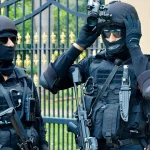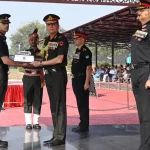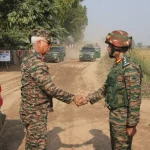The Balidan Badge is a distinguished emblem that represents more than just military achievement; it embodies the spirit of sacrifice, bravery, and an unwavering commitment to one’s nation. Exclusive to the Indian Army’s elite Para (Special Forces) personnel, this badge signifies not only an individual’s exceptional courage but also a deep-rooted tradition that stretches back to the trials and tribulations faced during World War II. This article delves into the history, meaning, significance, and criteria surrounding this prestigious badge, laying bare the attributes that transform a soldier into a hero in the eyes of their country and comrades.
Historical Context: The Emergence of the Parachute Regiment
The Balidan Badge’s origins can be traced back to the formation of the Parachute Regiment in India, which officially came into being in 1952. However, its roots go even deeper, emerging from the 50th Indian Parachute Brigade established during World War II. This brigade became renowned for its daring airborne operations, frequently landing in enemy territory to undertake strategic missions. Such undertakings highlighted the importance of mobility, surprise, and audacity—qualities that continue to define modern Special Forces units.
As the geopolitical landscape evolved in the post-war period, it became increasingly necessary for India to develop specialized units adept at six core areas: counter-terrorism, hostage rescue, covert reconnaissance, direct action, unconventional warfare, and special reconnaissance. Thus, in 1966, the Para (Special Forces) units were formally raised under the Indian Army, further solidifying the need for highly trained commandos who would engage in high-stakes operations.
The evolution of the Balidan Badge followed closely in the wake of these developments, created to honor the ultimate sacrifice made by soldiers in defense of India’s sovereignty. The badge encapsulates the spirit of selfless service, an ethos intrinsic to both the regiment and the broader ideals of the Indian Army.
Meaning and Symbolism of the Balidan Badge
The nomenclature of the badge—Balidan—derives from the ancient Sanskrit language, where the term “Bali” translates to sacrifice, and “Daan” means offering. Therefore, the Balidan Badge is not just an insignia; it encapsulates a soldier’s solemn vow to offer their life, if necessary, for the nation.
Symbols of Valor and Readiness
The badge’s design showcases a commando dagger pointed downwards, symbolizing both readiness and combat prowess, flanked by wings representing the airborne capabilities that the Para forces embody. Above the dagger rests a scroll bearing the word “बलिदान” inscribed in Devanagari script, thus linking the emblem not only to military traditions but also to the cultural ethos of India.
In deeper analysis, the dagger signifies the lethal precision with which the Para (Special Forces) execute their operations, while the wings connote freedom and the ability to strike at will—hallmarks of effective airborne operation.
Eligibility and Awarding Criteria
Obtaining the Balidan Badge is not an easy feat; it demands an extraordinary level of physical and mental fortitude. The following steps outline the rigorous path a soldier must tread to earn this prestigious emblem:
- Paratrooper Qualification: Candidates must first qualify as paratroopers, familiarizing themselves with airborne operations through basic parachute training.
- Special Forces Selection Course: Following paratrooper qualification, candidates enter a highly selective training program known for its extreme mental and physical challenges. This selection process is conducted twice yearly and has an attrition rate that can exceed 90%, emphasizing the caliber of individuals who make it through.
- “Balidan Padh” Deployment: Even upon successful completion of the selection course, soldiers must undertake a probationary operational deployment—termed “Balidan Padh”—for a year in a conflict zone. Only upon successful completion of this phase can they officially be awarded the Balidan Badge and fully integrate into the Para (SF) ranks.
Through this demanding pipeline, the ethos of sacrifice and bravery is instilled into recruits, thus ensuring that only the most dedicated and capable individuals earn the right to wear the badge.
Significance and Impact of the Badge
The Balidan Badge signifies much more than individual achievement; it stands as a symbol of the collective valor and dedication that frames the operational success of the Para (Special Forces). Its significance is multi-fold:
- Cultural and National Identity: The badge resonates deeply within the Indian cultural context, fostering a sense of pride and unity among soldiers and civilians alike. Those who wear it are regarded as embodiments of the country’s spirit and resilience.
- Morale Booster: Within the regiment and the wider Indian Army, the badge acts as a powerful motivator. The knowledge that one must complete an arduous training and combat operational process to earn the badge instills an esprit de corps that enhances unit cohesion and effectiveness.
- Operational Excellence: The Para (Special Forces) units, recognized by this badge, have etched their indelible mark in various military conflicts, including the Kargil War. Their extraordinary operational achievements substantiate the significance of wearing the Balidan Badge, reinforcing the values it embodies.
- Public Recognition: The badge enjoys a revered status within Indian society, inspiring future generations to recognize the valor of their armed forces. Additionally, it encourages young aspirants to pursue careers in the Defence forces, seeking to emulate the qualities exemplified by those who wear the badge.
Statistical Insights: The Rigorous Path to the Balidan Badge
To further highlight the demanding journey of attaining the Balidan Badge, here are some statistics and facts:
- Attrition Rate: The Special Forces selection process often sees attrition rates exceeding 90%, underlining the physical and psychological challenges faced by candidates.
- Duration of Training: The entire training and selection process from paratrooper qualification to operational deployment typically spans several months to over a year, showcasing the time and commitment required for soldiers.
- Operational Success: The Para (SF) units, awarded the Balidan Badge, have been critical in numerous counter-terrorism operations, significantly affecting regional and national security dynamics.
Challenges and Solutions
Despite the aspirational aura surrounding the Balidan Badge and the Para (Special Forces), the road to earning it is fraught with challenges:
- Mental and Physical Strain: The rigorous training can lead to mental health challenges among soldiers. Implementing comprehensive psychological support systems can help mitigate these issues.
- Reintegration into Civilian Life: Soldiers transitioning from high-stakes operational roles to civilian life may experience difficulty adjusting. Establishing better reintegration programs can ease this challenge, providing support through counseling and job placement services.
- Public Awareness: Although the Balidan Badge is celebrated among military circles, more public awareness is needed to sustain appreciation for the sacrifices made by the armed forces. Campaigns that spotlight stories of bravery and sacrifice can bridge this gap and foster national pride.
Future Trends and Predictions
Looking to the future, the significance of the Balidan Badge and the ethos it symbolizes may evolve due to several emerging trends:
- Technological Advancements: As warfare becomes increasingly tech-driven, the nature of Special Forces operations will change. However, the core values represented by the Balidan Badge will remain constant, guiding soldiers through modern challenges.
- Increased Role in National Security: Given the current security landscape, the importance of specialized units like the Para (SF) is likely to grow, necessitating an emphasis on advanced training methodologies and state-of-the-art equipment.
- Continued Cultural Relevance: As youth increasingly aspire to join the armed forces, maintaining and elevating the prestige associated with the Balidan Badge will be essential. Engagement with schools and youth organizations to promote military culture can help inspire future generations.
Conclusion
The Balidan Badge serves as a powerful emblem of sacrifice, courage, and commitment, transcending its role as a military insignia. Worn with pride by the elite Para (Special Forces), it encapsulates the essence of what it means to be a soldier in service to the nation. By understanding the badge’s history, meaning, and significance, we are reminded of the indelible sacrifices made by those sworn to protect India’s sovereignty. As we move forward, it is vital to honor and uphold the legacy of the Balidan Badge, fostering pride and respect for the brave souls it represents. Through awareness and celebration of their valor, we not only pay tribute to these extraordinary individuals but also inspire future generations to continue the tradition of sacrifice and service.












